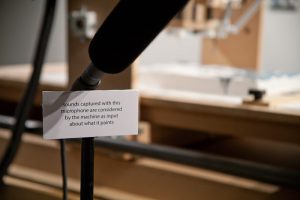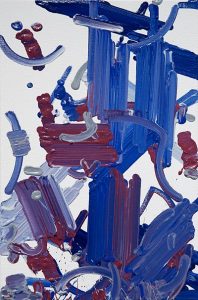
“Interactive Robotic Painting Machine” is an installation created by Benjamin Grosser in 2011. Benjamin Grosser is an artist who “focuses in the cultural, social, and political effects of software.” In this piece, he utilizes “computers, robotics, camera, microphones, mixers, speakers, a projector, oil paint, canvases, and custom software” to create paintings in response to noise. “Interactive Robotic Painting Machine” was created in response to an increase in social technologies, and is designed to “anticipate and support our needs and desires those interactions.” With this piece, Grosser asks, “as these systems grow in complexity, or intelligence, how does that intelligence change what passes through them?” and “how does that intelligence evolve to make its own work for its own needs?”
Rather than mapping exactly what it hears, the robot considers the input audio and decides what to paint. The machine uses artificial intelligence and “makes its own decisions.” Grosser is exploring ideas of consciousness and agency, asking the question, “is this machine alive, with agency as yet another piece of the technium, or is it our own anthropomorphization of the system that makes us think about it in these ways?” He has created a robot that can be influenced by people and the environment.


Grosser has had much success with his “Interactive Robotic Painting Machine.” The machine has been able to interpret its surroundings and create artwork as a response. The machine has performed in gallery spaces, on stage with a violinist, and taking commands from Grosser himself. The machine, created as a response to Grosser’s inquiries, effectively responds to them. Nevertheless, the answer to whether the machine has agency is still unknown. While it is true that the machine can respond to its environment, it was trained by Grosser.

This project relates to the themes presented in our course in a number of ways. The machine is able to respond to its environment by receiving noise, translate that noise into a language it can understand, and then performing a physical response. The piece balances mechanism and computation when it undergoes that process. The artificial intelligence of the piece is computation work, while the painting mechanism is a physical process. The basic workflow of the robot as it executes is painting is an input-output structure. It takes in sensory information, computes that information into something it can understand, and then produces a painting with the physical aid of motors and robotics. One key takeaway from this piece is the importance of transitioning from computation to physicality. Without it, this piece would not function. While we may not have the skills nor time to create something as complex as this in our class, it serves as a functioning model for our own projects with the Children’s Museum. As with Grosser’s piece, we will aim to create something that is interactive and uses an input to create a physical output that is stimulating and exciting.

Sources
http://bengrosser.com/projects/interactive-robotic-painting-machine/#how
Leave a Reply
You must be logged in to post a comment.